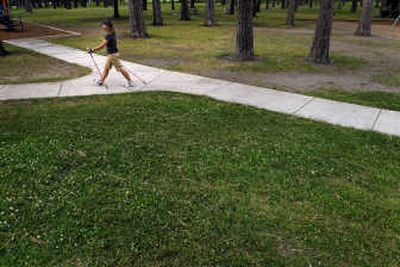Stepping it up

We’re all supposed to be logging our 10,000 steps a day. And the government says we’re supposed to get 30 to 60 minutes of moderate exercise most days, which, for many people, means a stroll around the neighborhood.
But are you getting the biggest exercise bang out of your walking routine?
Danna Snow doesn’t think so.
“People don’t push themselves enough to get anything out of walking,” says Snow, a personal trainer in Spokane. “You should be sweating. If you’re comfortable, then you’re probably not going fast enough. If you don’t have to think about what you’re doing, then you’re not going fast enough.”
Of course, any physical activity will burn calories. And even a slow stroll around the block is better than sitting on your couch eating chips.
People who have been walking for some time, though, and aren’t seeing the results they want, may want to kick things up a notch. (Check with your doctor first if you have any health issues that might keep you from strenuous exercise.)
Running can be tough on the joints and isn’t for everybody, so it makes sense to learn how to reap the most from that daily walk.
In her training sessions, Snow sings the praises of interval training. People should alternate a few minutes of moderately paced walking with speed-walking. (Or you can do this block by block, or using another landmark.)
“It shocks your metabolism,” Snow says. “It really gets your heart rate going.”
When speed-walking, shorten your stride and walk heel-to-toe.
“You almost glide,” she says. “You incorporate your arms. You really get your arms going. It really is a whole body exercise.”
Patti Jouppi knows well the benefits of getting your arms moving while walking. For the past five years, the Spokane teacher and artist has been Nordic walking. And she regularly teaches other people the vigorous walking style through Parks and Recreation classes.
Nordic walkers carry special poles with rubber-based feet that roll forward when planted on the ground.
“You use it to propel yourself as you’re walking,” Jouppi says. “It incorporates the whole upper half of your body.”
Some have even said that Nordic walking burns 50 percent more calories than traditional walking.
For Jouppi, that’s reason enough to get past the slight embarrassment of strutting around carrying poles on dry land.
“That’s something you have to deal with,” she says. “You have to come up with your own sarcastic remark to, ‘Where are your skis?’ “
People who aren’t quite up to strenuous Nordic walking can still keep their walking workout from getting stale.
First, start by walking a few minutes more each day – just five minutes more can make a difference, says Vicki Marsh, coordinator for active older adults at the YMCA in Spokane.
“So you’re not overdoing the joints,” Marsh says.
Consider doing an easy walk one day and a faster walk the next. And seek out some different terrain (or bump up the incline on your treadmill).
“Throwing hills in there is really going to work your heart and lungs,” Marsh says.
Marsh recommends that walkers monitor their “rate of perceived exertion,” to decide whether they should be working harder or easing up. Think of a scale of one through 10, with 10 being completely exhausted and one not working at all.
“You want to be between four and five,” Marsh says. “You could throw in a seven or eight … You don’t want to be going so slow you’re not getting any benefit out of it.”